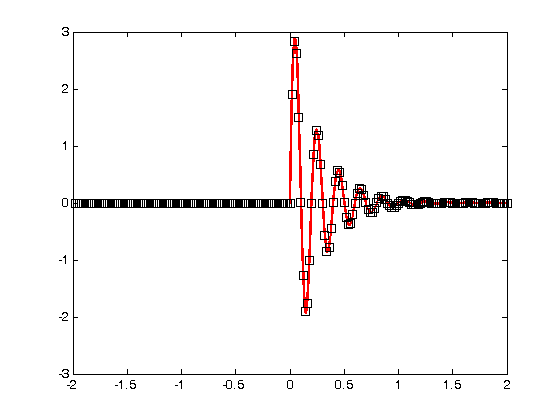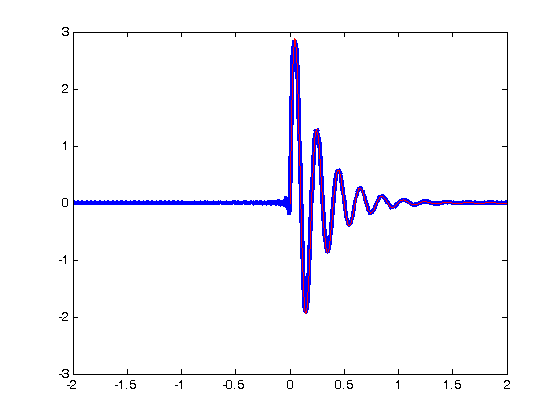% Jake Bobowski % March 1, 2018 % Created using MATLAB R2014a % In this MATLAB tutorial we start with a cntinuous function of time from % which we draw samples at a uniform sampling rate. The sampling rate is % chosen to be higher than the maximum appreciable frequency component % contained in the original function of time. We then attempted to % reconstruct the original continuous function from the sampled data. clearvars % Here's the original function from which samples will be drawn. ts0 = linspace(0, 2.5, 1000); T = 0.2; tau = 0.25; A = 3.5; f = A*sin(2*pi*ts0/T).*exp(-ts0/tau); plot(ts0,f, 'r-', 'LineWidth', 2) axis([-2 2 -3 3]) % Now do the sampling. There are Ns samples between -tmax and +tamx. % Therefore the time between samples is 2*tmax/(Ns - 1), or the sample % frequency is (Ns - 1)/(2*tmax). Ns = 1001; tmax = 10; ts = linspace(-tmax, tmax, Ns); ys = A*sin(2*pi*ts/T).*exp(-ts/tau); for i = 1:Ns if ts(i)<0 ys(i) = 0; end end; % Plot the samples on top of the original continuous function. hold on; plot(ts, ys, 'ks') hold off; % Start a new figure. figure; % Define a variable (time). syms t % Here again are the sampling period and frequency. Ts = ts(2)-ts(1); fs = 1/Ts; % This function will become the reconstructed signal. yRe = @(t) 0; % Let's do the reconstrcution using the sinc function! set(0,'RecursionLimit',2000) for i = -(Ns-1)/2:(Ns-1)/2 n = i + (Ns-1)/2 + 1; yRe = @(t) yRe(t) + ys(n)*sin(pi*fs*(t-i*Ts))./(pi*fs*(t-i*Ts)); end % Now make some time values and plot the reconstructed signal. tt = linspace(-2.5, 2.5, 1000); plot(tt, yRe(tt), 'b-', 'LineWidth', 3) axis([-2 2 -3 3]) % Plot the original continuous function on top of the reconstructed signal % to facilitate easy comparison. hold on; plot(ts0,f, 'r-', 'LineWidth', 0.5) hold off;

